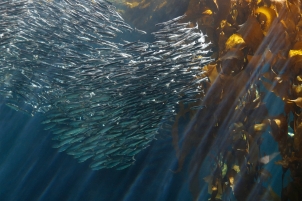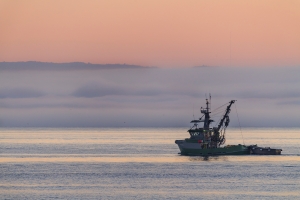As new members of Congress get up to speed on key issues like oceans and climate, we’re in Washington, D.C., to raise our voice for ocean conservation.

On May 1, Jennifer Dianto Kemmerly, the Aquarium’s vice president of global ocean initiatives, testified before the House Natural Resources Subcommittee on Waters, Oceans and Wildlife about the state of fisheries.
Jenn was invited by Rep. Jared Huffman (D-San Rafael), the subcommittee’s chair, to provide information on the status of U.S. and global fisheries. Building on her remarks to the United Nations in 2017, she provided insight into seafood markets and made policy recommendations to advance the sustainability of U.S. and global fisheries.
America leads the world in sustainable fisheries
U.S. fisheries perform well compared to the rest of the world, Jenn told the committee, largely thanks to strong management under a landmark federal law, the Magnuson-Stevens Act (MSA). Congress has been instrumental in positioning the United States as a global leader on fisheries, both by supporting science-based management under the MSA, and by funding crucial research by the National Oceanic and Atmospheric Administration (NOAA).

The MSA has been successful in rebuilding U.S. stocks, decreasing the risk of overfishing and elevating the long-term sustainability of fisheries around the country. In recent years, many once-depleted U.S. fish stocks have recovered, and the number of overfished stocks has fallen. Seafood Watch and other sustainability programs have evaluated 95 percent of U.S. fisheries by production; of those, 91 percent is rated green (Best Choice) or yellow (Good Alternative), or is eco-certified, meaning they meet the equivalent of at least a Seafood Watch yellow rating. This is a much higher level of environmental sustainability than seen in global fisheries.
As a result, the U.S. is now positioned as a world leader in sustainable fishery management. Countries around the world, as well as the United Nations, are using the U.S. approach as a model for improving their own fishery policies and regulations.
Healthy fisheries are good for business
The health of our federal fisheries is connected to the health of our national economy. In 2016, the U.S. fishing and seafood industries generated $212 billion in sales impacts, contributed $100 billion to gross domestic product and supported 1.7 million jobs.

Meanwhile, consumer demand for sustainable seafood is increasing. In a recent poll, 70 percent of North American participants said they want to hear more from companies about product sustainability. And more than half of U.S. consumers say they’re willing to pay more for sustainable seafood. In response to this rising consumer demand, more than 90 percent of U.S. retailers have made sustainable seafood commitments.
Trouble in the global ocean
While U.S. fisheries are in good shape, wild seafood stocks across the global ocean—which account for 45 percent of seafood production worldwide—are under pressure. Overfishing is on the rise; and illegal, unreported and unregulated (IUU) fishing continues to place a burden on fishing fleets and governments that play by the rules. Each year, IUU fishing costs law-abiding U.S. and international fishing fleets and governments between $10 billion and $23.5 billion. This economic burden is one reason the United States has been a leader in the fight against IUU fishing
Although America’s own fisheries are well managed, the U.S. imports over 90 percent of our seafood from abroad, and it can be difficult to trace those products. Many of them come from countries with weak fishery management and from sources that experience IUU fishing or human rights abuses.
A call for seafood stewardship
It’s critical that Congress maintain America’s strong, science-based fishery management framework while supporting efforts to improve seafood sustainability around the world. Jenn called on Congress to:

- Maintain the core conservation provisions of the Magnuson-Stevens Act, including science-based management, ending overfishing, rebuilding depleted stocks and ensuring strong accountability.
- Support investments in research, technology and innovation, including through cooperative research, to guide management decisions.
- Work with fishing communities to build critical infrastructure, supply chains and domestic marketing opportunities.
- Continue to advance solutions that mitigate bycatch.
- Prioritize work toward more operational ecosystem-based management plans that incorporate habitat, forage fish and climate impacts.
- Increase the transparency and traceability of imported seafood products through full implementation of the Seafood Import Monitoring Program, and expand the program to include all seafood products.
- Advocate for precautionary, science-based management and strong compliance through Regional Fisheries Management Organizations.
- Utilize existing authorities and programs that advance on-the-water enforcement to address IUU fishing, such as NOAA international enforcement trainings and collaboration with technology providers
- Increase government oversight by NOAA, the State Department and other agencies to ensure our markets support safe labor practices and social responsibility.
- Support collaboration between NOAA, the fishery management councils, academics and stakeholders to understand the impacts of climate change.

Working together for thriving fisheries and a healthy ocean
At a time when our ocean and global fisheries are under threat, the MSA has positioned the United States as a global model of science-based, environmentally sustainable fishery management.
Working together, the public and private sectors can continue to strengthen American fisheries and leverage our purchasing power to bring global fisheries up to U.S. standards. The Aquarium stands ready to work with Congress to support solutions that ensure the long-term health of our ocean’s fisheries—in U.S. waters and beyond.
Featured image: A school of rockfish swims through the Monterey Bay kelp forest. Photo by Patrick Webster.

One thought on “Speaking up for sustainable fisheries”